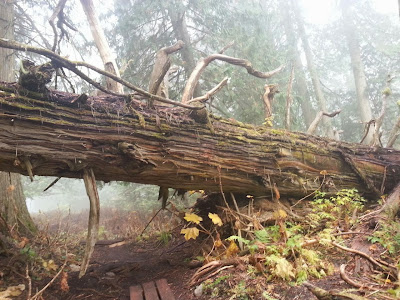1. What is the nature of this place? What themes or thoughts or actions make sense in this place?
- Traditional Ecological Knowledge - the cedars are foundational to Aboriginal culture in BC (building material, ceremonial purposes etc.); the dominant understory shrub here is Devil's Club (Oplopanax horribilis), also an important plant for First Peoples, primarily for powerful medicine as I understand it. There is a lot of potential for both the study and, with some respectful protocol, the practice of ethobotany. We saw wild ginger on our walk (delicacy), but we also saw a highly poisonous hellabore.
- Ecosystem Relationships - as mentioned above this place is unique and it is possible to see variety of biogeoclimatic processes at work. For example, understanding soil moisture on this slope position anf within the local subclimate is key to understanding why these forests contain giant redcedars instead of the usual spruce, pine, and fir. This forest offers many opportunities to examine the nurtrient cycle and the stages of forest renewal. Beneath the rootwheels thrown up by trees blown over in winter storms there are natural soil pits that allowed us to see and touch the "till" (parent material) and clay loam (surface soil). We also happened across Dave King, a famous hiker and trail-maker in our region who was repairing a section of board walk. He gave our group short talk and lent me his shovel and pulaski so I could did a little soil pit to show why these soils were part of the reason why the redcedars thrived. Digging through the first bit of humus was the opening to talk about biodiversity. Boreal and sub-boreal forests (like this rainforest) owe much of their vitality to biological action in the soil, whereas in tropical rainforests most of the action is in the canopy.
2. How much can or should I wrangle students; is it important for me to convey what I find valuable about this forest?
- In the end, I think it is important to throw out some "teacher wisdom" when the scene is right, but there is only so much control that can be expected when you have teens running around in a forest.
- Maybe the key is to have a few places to stop with something specific in mind, rather than trying to create running commentary. This feels much more like being "present" which in the case of the Ancient Forest is not hard. Lots of "presence" in there to attend to.
3. What does nature/place-based learning look like? What can we learn about ourselves from this specific place?
- For me this came down to senses. The sweet forest debris, the wash of scented needles born down on the mist, the noise of water (trickles here and there, a substantial waterfall at the top), the sounds of twigs breaking and students calling out and laughing. There was a warm and cool about the day, a chance to get dirt on one's hands and to feel something sharp in the form of a rock or branch stub. This simply does not happen in a classroom.
- I tried to do two things to get students out of their urban armour. First, I led about half of them off the path into some blowdown and brush -- by led I mean I simply ran off towards a fallen tree and half of them followed me. Second, I egged almost all of them to climb up to the base of Treebeard Falls and play around in the rocks and water for a while. In the closed-in space (rock walls on three sides, clothed in moss and ferns, glittering stones about our feet), I asked them to close their eyes and listen for 30 seconds, just breath and listen. I have no idea what they got out of that but I sense it was a little magic moment. I felt that way, anyways.
- Some students stuck in a big pack, others wandered around in 2s or 3s, and some were anxious to move on (e.g. pitstops to talk about lichens did not appeal) or did not want to catch up (having fund taking photos or looking at stuff). Learning in nature takes on intense differentiation -- I'm realizing that unusual settings can amplify the identity-rich markers that are often difficult to see when the kids are stuck in the melting pot of a high school. For example, it was easier to see who was a leader, who was a helper, who needed affirmation, who wanted to share stories, and who wanted to experience the perceived learning intentions on their own terms. This concept was pointed out to me many times by an early mentor, Norm Booth -- we never really know what students learn. We assess student output using our up-to-date tools, and they sometimes tell us what they've learned, but the actual stuff that takes place in their brains is not easily defined; it is abstract and profound, perhaps even sacred.
4. What should I do next time, next semester when I take a group of Grade 12s out here?
- I think a bit more pre-reading is in order, so that the forest denizens (the trees, the devil's club, the valley itself) have more a of backstory for the students.
- I loved that we brought sandwich fixings and made our own lunch. Repeat that.





2 comments:
Leading the learning...rather than teaching. Letting a sense of place help shape the students' thinking vs. reading a text...sharing a passion for learning vs. passive interaction...would love to be in that class!
I find your blog interesting! When leading students it is not all about the book but what's inside of it, to teach them with experience and not by lecturing. The opportunity to be within this kind of experience even though I'm just reading it, captivate my senses to love wood even more. Looking forward to read more from you.
Post a Comment